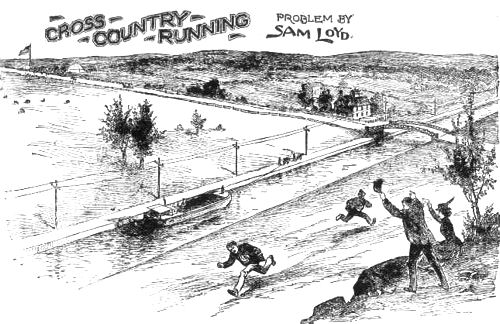



HERE IS A PROBLEM from the popular pastime of the “Hare and Hounds” which will interest the young folks, while at the same time it may cause the sluggish blood to course anew in some of us old-time paper chasers with pleasant recollections of cross-country feats of our college days.
The sketch illustrates a clever and successful case of the hound in capturing the hare. The boy running this way is the hound and he is chasing the other fellow, who is supposed to be one of the hares. In the picture it does not look as if the hound was after that particular hare, as they are running in opposite directions.
He is chasing him, however, and very successfully, too, as you will readily see when the ruse is explained, for that is where the point of the problem comes in.
The hound was pursuing the hare, but in place of catching it found that he could just hold his own—in other words, the other fellow was just, as good a runner as he was and it was a hopeless task to try to catch him by a direct follow, as he had a good lead of twenty-five yards.
“Home” is shown far back in the picture, marked with an American flag. The hare is 250 yards from the bridge, from whence a straight run of 600 yards at right angles brings him to safety.
It looks hopeless for the hound, doesn't, it? But just at that moment the hound realized that there was another bridge to the left, which cannot be seen in the picture, and that by crossing this bridge and taking a cut across the field, through that drove of cows, this hypotenuse line might possibly be shorter than the other one. It was a successful ruse—a sort of happy inspiration, so to speak—for after he had made the successful run and collared his hare, we measured the distance and found that from the exact spot where the hare is now shown to be, the two routes would be equally long. By spinning in the opposite direction, therefore, the twenty-five yards lead was transferred from the hare to the hound, who crossed the other bridge, cut across on the line of the hypotenuse and came in just twenty-five yards to the good.
Of course everyone can see it now, but, the puzzle now is to tell just how many feet that hound has to run before he comes to the lucky bridge, which is not shown in the picture.
This problem is presented to our college students and high school boys, as well as all others mathematically inclined, for the purpose of teaching a simple rule well worth knowing.
First to give the answers: It may be said that the hound runs back 111 yards 1 foot and 1 and 1/11 of an inch to the left-hand bridge, and thence across the field on the hypotenuse line 713 and 7/11 yards.
This shows the hare to be 850 yards from the home flag going by either route. Mathematicians show that the total length along the canal would be 111 and 4/11 yards. Plus the 25 yards to the hare, plus the 250 yards to the right-hand bridge, would make the distance from bridge to bridge 386 and 4/11 yards as one side of a triangle, with 600 yards as the other, which gives 713 and 7/11 yards as the lien of the hypotenuse, according to Euclid’s forty-seventh proposition. This proves the answer to be correct, which I will now proceed to obtain by the natural puzzle method.
To discover that unknown distance from the hare to the left-hand bridge, when the two routes are of the same length, merely divide the base of the triangle (that 600) by the distance of the hare to the bridge, 250, and to the quotient add 2, and with that sum once more divide the base, and the quotient will be the distance from the hare to the left-hand bridge, viz., 250)600(2.4, to which we add 2—4.4, which, divided into the 600, gives 136 and 4/11 yards as the distance from the hare to the left-hand bridge, and as the two routes are of equal length it would make the cross-lots cut 713 and 7/11 yards, as previously mentioned, and we have not stumbled over any square roots on our run.
2.
Why is a blacksmith’s apron like a convent? Because it keeps off the sparks.
Why does a blacksmith never eat his apron? Because it goes against his stomach.
Why is a wick of a candle like Athens? Because it's in Greece (grease).
Why is a fender like Westminster Abbey? Because it contains the ashes of the grate (great).
If you were obliged to swallow a man, what kind of an one would you prefer to swallow? A little Dublin porter.
What four letters of the alphabet would frighten a thief? O I C U (Oh, I see you!).
Why must a magistrate be cold and chilly? Because he is just ice (justice).
What is the difference between a new five-cent piece and an old- fashioned quarter? Twenty cents.
What is the cheapest way to buy a fiddle? Buy a little medicine and get a vial in (violin).
What profession is a postman? He is a man of letters.
[Page 138]